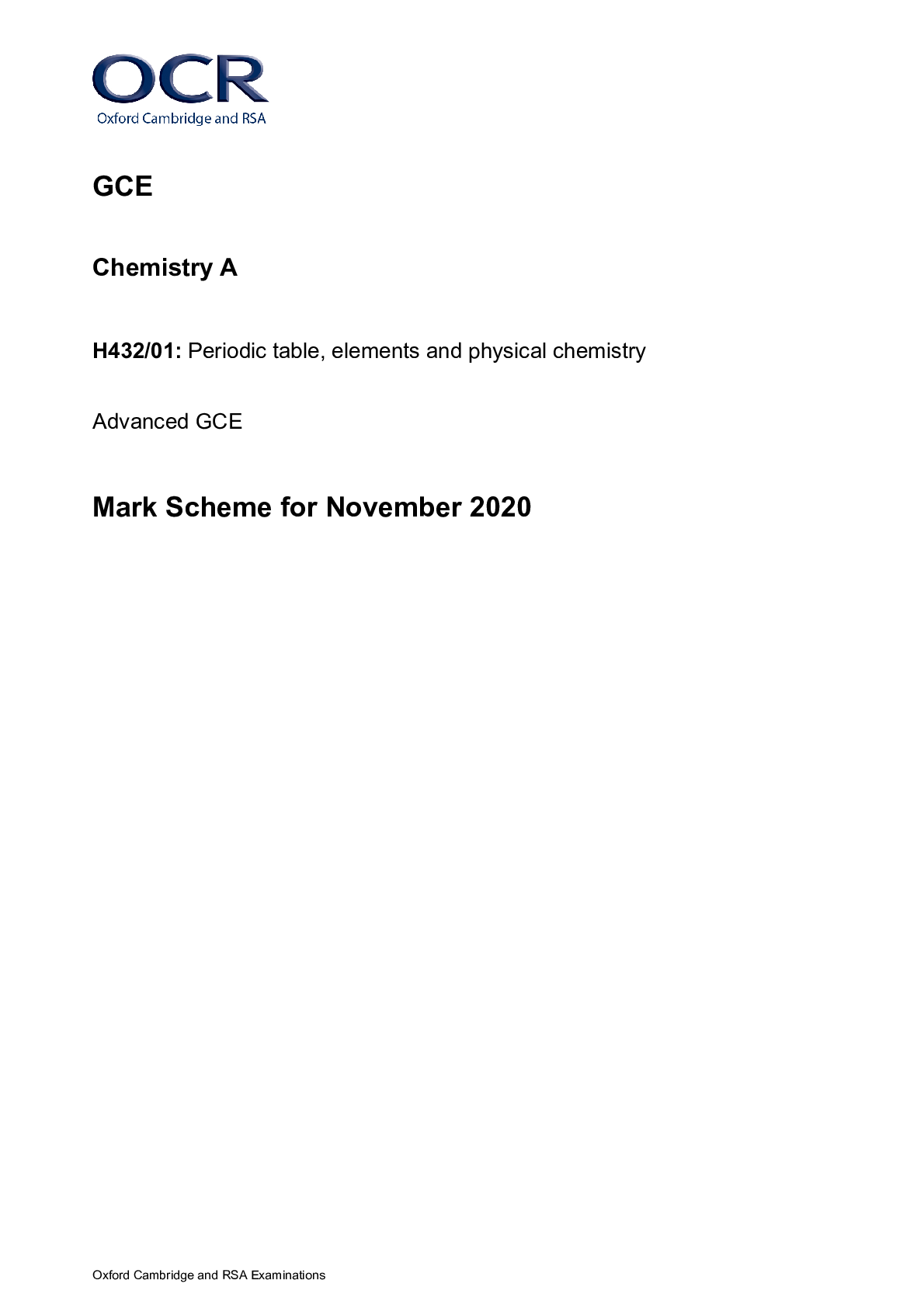Mathematics > AS Mark Scheme > GCE Further Mathematics A Y545/01: Additional Pure Mathematics Advanced GCE Mark Scheme for Autumn 2 (All)
GCE Further Mathematics A Y545/01: Additional Pure Mathematics Advanced GCE Mark Scheme for Autumn 2021
Document Content and Description Below
Oxford Cambridge and RSA Examinations GCE Further Mathematics A Y545/01: Additional Pure Mathematics Advanced GCE Mark Scheme for Autumn 2021Oxford Cambridge and RSA Examinations OCR (Oxford Cam... bridge and RSA) is a leading UK awarding body, providing a wide range of qualifications to meet the needs of candidates of all ages and abilities. OCR qualifications include AS/A Levels, Diplomas, GCSEs, Cambridge Nationals, Cambridge Technicals, Functional Skills, Key Skills, Entry Level qualifications, NVQs and vocational qualifications in areas such as IT, business, languages, teaching/training, administration and secretarial skills. It is also responsible for developing new specifications to meet national requirements and the needs of students and teachers. OCR is a not-for-profit organisation; any surplus made is invested back into the establishment to help towards the development of qualifications and support, which keep pace with the changing needs of today’s society. This mark scheme is published as an aid to teachers and students, to indicate the requirements of the examination. It shows the basis on which marks were awarded by examiners. It does not indicate the details of the discussions which took place at an examiners’ meeting before marking commenced. All examiners are instructed that alternative correct answers and unexpected approaches in candidates’ scripts must be given marks that fairly reflect the relevant knowledge and skills demonstrated. Mark schemes should be read in conjunction with the published question papers and the report on the examination. © OCR 2021Y545/01 Mark Scheme October 2021 2 1. Annotations and abbreviations Annotation in RM assessor Meaning ✓and BOD Benefit of doubt FT Follow through ISW Ignore subsequent working M0, M1 Method mark awarded 0, 1 A0, A1 Accuracy mark awarded 0, 1 B0, B1 Independent mark awarded 0, 1 SC Special case ^ Omission sign MR Misread BP Blank Page Seen Highlighting Other abbreviations in mark scheme Meaning dep* Mark dependent on a previous mark, indicated by *. The * may be omitted if only one previous M mark cao Correct answer only oe Or equivalent rot Rounded or truncated soi Seen or implied www Without wrong working AG Answer given awrt Anything which rounds to BC By Calculator DR This question included the instruction: In this question you must show detailed reasoning.Y545/01 Mark Scheme October 2021 3 2. Subject-specific Marking Instructions for A Level Mathematics A a Annotations must be used during your marking. For a response awarded zero (or full) marks a single appropriate annotation (cross, tick, M0 or ^) is sufficient, but not required. For responses that are not awarded either 0 or full marks, you must make it clear how you have arrived at the mark you have awarded and all responses must have enough annotation for a reviewer to decide if the mark awarded is correct without having to mark it independently. It is vital that you annotate standardisation scripts fully to show how the marks have been awarded. Award NR (No Response) - if there is nothing written at all in the answer space and no attempt elsewhere in the script - OR if there is a comment which does not in any way relate to the question (e.g. ‘can’t do’, ‘don’t know’) - OR if there is a mark (e.g. a dash, a question mark, a picture) which isn’t an attempt at the question. Note: Award 0 marks only for an attempt that earns no credit (including copying out the question). If a candidate uses the answer space for one question to answer another, for example using the space for 8(b) to answer 8(a), then give benefit of doubt unless it is ambiguous for which part it is intended. b An element of professional judgement is required in the marking of any written paper. Remember that the mark scheme is designed to assist in marking incorrect solutions. Correct solutions leading to correct answers are awarded full marks but work must not always be judged on the answer alone, and answers that are given in the question, especially, must be validly obtained; key steps in the working must always be looked at and anything unfamiliar must be investigated thoroughly. Correct but unfamiliar or unexpected methods are often signalled by a correct result following an apparently incorrect method. Such work must be carefully assessed. When a candidate adopts a method which does not correspond to the mark scheme, escalate the question to your Team Leader who will decide on a course of action with the Principal Examiner. If you are in any doubt whatsoever you should contact your Team Leader.Y545/01 Mark Scheme October 2021 4 c The following types of marks are available. M A suitable method has been selected and applied in a manner which shows that the method is essentially understood. Method marks are not usually lost for numerical errors, algebraic slips or errors in units. However, it is not usually sufficient for a candidate just to indicate an intention of using some method or just to quote a formula; the formula or idea must be applied to the specific problem in hand, e.g. by substituting the relevant quantities into the formula. In some cases the nature of the errors allowed for the award of an M mark may be specified. A method mark may usually be implied by a correct answer unless the question includes the DR statement, the command words “Determine” or “Show that”, or some other indication that the method must be given explicitly. A Accuracy mark, awarded for a correct answer or intermediate step correctly obtained. Accuracy marks cannot be given unless the associated Method mark is earned (or implied). Therefore M0 A1 cannot ever be awarded. B Mark for a correct result or statement independent of Method marks. Unless otherwise indicated, marks once gained cannot subsequently be lost, e.g. wrong working following a correct form of answer is ignored. Sometimes this is reinforced in the mark scheme by the abbreviation isw. However, this would not apply to a case where a candidate passes through the correct answer as part of a wrong argument. d When a part of a question has two or more ‘method’ steps, the M marks are in principle independent unless the scheme specifically says otherwise; and similarly where there are several B marks allocated. (The notation ‘dep*’ is used to indicate that a particular mark is dependent on an earlier, asterisked, mark in the scheme.) Of course, in practice it may happen that when a candidate has once gone wrong in a part of a question, the work from there on is worthless so that no more marks can sensibly be given. On the other hand, when two or more steps are successfully run together by the candidate, the earlier marks are implied and full credit must be given. e The abbreviation FT implies that the A or B mark indicated is allowed for work correctly following on from previously incorrect results. Otherwise, A and B marks are given for correct work only – differences in notation are of course permitted. A (accuracy) marks are not given for answers obtained from incorrect working. When A or B marks are awarded for work at an intermediate stage of a solution, there may be various alternatives that are equally acceptable. In such cases, what is acceptable will be detailed in the mark scheme. If this is not the case please, escalate the question to your Team Leader who will decide on a course of action with the Principal Examiner. Sometimes the answer to one part of a question is used in a later part of the same question. In this case, A marks will often be ‘follow through’. In such cases you must ensure that you refer back to the answer of the previous part question even if this is not shown within the image zone. You may find it easier to mark follow through questions candidate-by-candidate rather than question-by-question. f We are usually quite flexible about the accuracy to which the final answer is expressed; over-specification is usually only penalised where the scheme explicitly says so. • When a value is given in the paper only accept an answer correct to at least as many significant figures as the given value. • When a value is not given in the paper accept any answer that agrees with the correct value to 3 s.f. unless a different level of accuracy has been asked for in the question, or the mark scheme specifies an acceptable range. NB for Specification B (MEI) the rubric is not specific about the level of accuracy required, so this statement reads “2 s.f”.Y545/01 Mark Scheme October 2021 5 Follow through should be used so that only one mark in any question is lost for each distinct accuracy error. Candidates using a value of 9.80, 9.81 or 10 for g should usually be penalised for any final accuracy marks which do not agree to the value found with 9.8 which is given in the rubric. g Rules for replaced work and multiple attempts: • If one attempt is clearly indicated as the one to mark, or only one is left uncrossed out, then mark that attempt and ignore the others. • If more than one attempt is left not crossed out, then mark the last attempt unless it only repeats part of the first attempt or is substantially less complete. • if a candidate crosses out all of their attempts, the assessor should attempt to mark the crossed out answer(s) as above and award marks appropriately. h For a genuine misreading (of numbers or symbols) which is such that the object and the difficulty of the question remain unaltered, mark according to the scheme but following through from the candidate’s data. A penalty is then applied; 1 mark is generally appropriate, though this may differ for some units. This is achieved by withholding one A or B mark in the question. Marks designated as cao may be awarded as long as there are no other errors. If a candidate corrects the misread in a later part, do not continue to follow through. Note that a miscopy of the candidate’s own working is not a misread but an accuracy error. i If a calculator is used, some answers may be obtained with little or no working visible. Allow full marks for correct answers, provided that there is nothing in the wording of the question specifying that analytical methods are required such as the bold “In this question you must show detailed reasoning”, or the command words “Show” or “Determine”. Where an answer is wrong but there is some evidence of method, allow appropriate method marks. Wrong answers with no supporting method score zero. If in doubt, consult your Team Leader. j If in any case the scheme operates with considerable unfairness consult your Team Leader.Y545/01 Mark Scheme October 2021 6 Question Answer Marks AOs Guidance 1 41723 = 10163 + 2162 + 1516 + 11 M1 A1 1.1 1.1 Writing in terms of powers of 16; correct = A2FB16 A1 1.2 [3] 2 (a) {e, a, a2} B1 1.1 {e, b} {e, ab} {e, a2b} B1 B1 B1 1.1 1.1 1.1 Ignore inclusion of {e}, G [4] (b) G is isomorphic to the symmetric group of three elements i.e. D3 (the symmetries of the ) or S3 (the permutations of 3 symbols) B1 2.5 Accept “the non-cyclic group of order 6” [1] 3 (a) p q = 111 2 51 − kji = − 3 6 3 = −1 2 1 3 t = –1 M1 A1 3.1a 2.2a Possibly BC Correct vector product; t correct [2] (b) Vol. OABC = 1 6 | p q . r | = 16 1 2 6 3 3 • − t = 1 6 | 12 + 3 – 3t | B1 M1 1.1 1.1 A correct scalar triple product involving t Correct formula attempted Solving 5 – t = 26 and/or t – 5 = 26 t = –21 or 31 M1 A1 3.1a 2.2a Method may be implied by one correct t [4]Y545/01 Mark Scheme October 2021 7 Question Answer Marks AOs Guidance 4 x = 3a + 1 = 11b + 5 mod 11: 3a 4 15 a 5 (mod 11) (since hcf(3, 11) = 1) (a = 11c + 5) M1 M1 1.1 2.1 Equating first two equations Working mod 11 x = 33c + 16 A1 3.1a or via b = 3c + 1 (working mod 3) 2x = 66c + 32 = 17d + 5 mod 17: 15c –27 5c –9 8 25 M1 2.1 Substituting into 3rd equation and working mod 17 c 5 (mod 17) (since hcf(5, 17) = 1) Then c = 17e + 5 x = 561e + 181 or x 181 (mod 561) A1 2.2a Stating at least one of either hcf(3,11) = 1 or hcf(5,17)=1 B1 2.4 Alternative Method 1 2x 5 22 x 11 (mod 17) –6 (mod 17) M1 Then x –6 (mod 11) x –6 (mod 187) 181 M1 A1 since hcf(11, 17) = 1 B1 Note that 181 is already 1 (mod 3) M1 OR continue as above: x = 3a + 1 = 187b + 181 Since there is a unique solution (mod 3 11 17 = 561) (as 3, 11, 17 are pairwise co-prime) the solution is x 181 (mod 561) A1 Alternative Method2 The Chinese Remainder Theorem (CRT) There is a unique solution mod M = 3 11 17 = 561 B1 2x 5 22 x 11 (mod 17) M1 a1 = 1, M1 = 187 3 = M , R1 is the reciprocal of M1 mod 3 = 1 M1 Since 187 1 (mod 3) anyway For any one set of terms correct a2 = 5, M2 = 51 11 = M , R2 is the reciprocal of M2 mod 11 = 8 Since 51 7 (mod 11) and 7 8 = 56 1 (mod 11) a3 = 11, M3 = 33 17 = M , R3 is the reciprocal of M3 mod 17 = 16 A1 All three sets of terms correct. Since 33 –1 16 (mod 17) Then x a1 M1 R1 + a2 M2 R2 + a3 M3 R3 (mod 561) M1 CRT employed correctly (in principle) = 11871 + 5518 + 113316 = 8035 181 (mod 561) A1 BC [6]Y545/01 Mark Scheme October 2021 8 Question Answer Marks AOs Guidance 5 (a) Differentiating zyx 222 xyz −=++ 1 partially w.r.t. either x or y M1 1.1 Attempt with LHS correct x): yz z x xy z x zx + = + 22 y): xz z y xy z y zy + = + 22 A1 A1 1.1 1.1 First correct Correct or FT x y (by symmetry) x. + y. ( ) xyz z y y z x xy x z y y z x 2 22 2 xzyx + 2 ++ + = + M1 3.1a z − xy)2( x xz + y yz 2( −−= yxxyz 22 ) Now zyx 222 xyz −=++ 1 xyz x y z − − = + 2 2 2 1 M1 1.1 giving )2( ( ) 12 z2 z y y z x z xy x += − + A1 2.2a AG legitimately obtained [6] (b) If both z x and z y are zero … M1 2.1 Considering conditions for stationary points … then LHS = 0 while RHS 2 (i.e. > 0) () A1 2.4 Contradiction justified [2] 6 (a) Closed … YES since the ‘product’ of 2 complex numbers is a third B1 2.4 ‘Yes’ with valid reason [1] (b) [(a + i b) (c + i d)] (e + i f) = [ac + i (b + ad)] (e + if) M1 1.2 Attempt at first of (pq)r or p(qr), correct to here = ace + i (b + ad + acf) A1 1.1 (a + i b) [(c + i d) (e + i f)] = (a + i b) [ce + i(d + cf)] M1 2.1 Attempt at the other, correct to here = ace + i (b + a[d + cf]) = … A1 1.1 Must be convincingly shown equal to first answer [4] (c) 1 + i 0 is the identity B1 2.2a since (1 + i0) (a + i b) = 1∙a + i(0 + 1b) = (a + i b) (1 + i 0) B1 2.4 Demonstrated (condone one-side only) [2] (d) (a + i b) (c + i d) = 1 ac + i (b + ad) = 1 M1 3.1a Test for an inverse of a general element a c 1 = and b a d = − A1 2.2a Both components of inverse element found S is the set of complex numbers with non-zero real part (The ‘exclusions’ are those complex numbers with zero real part; i.e. the strictly imaginary numbers)) B1 3.2a Explained [3]Y545/01 Mark Scheme October 2021 9 Question Answer Marks AOs Guidance 7 (a) In = 1 2 0 cosn x dx = − 1 2 0 1 n cos cos xx dx M1 1.1 Correct splitting and attempted use of ‘parts’ = n −1 sin cos xx − − − − 1 2 0 n cos)1( n 2 .( sin )sin xxx dx A1 1.1 Correct unsimplified = 0 + − − ( ) − 1 2 0 n n 2 cos1cos)1( 2 xx dx = (n – 1){In – 2 – In} M1 3.1a Setting up into Ik terms only n In = (n – 1) In – 2 A1 1.1 AG legitimately obtained [4] (b) I0 = 1 2 π evaluated and In = nn−1 In – 2 used repeatedly M1 1.1 Note: candidates may choose to evaluate directly as a starting-point I2 = 14 π gives I2 = 1 4 π, I4 = 3 16 π, I6 = 5 32 π, I8 = 35 256 π A1 1.1 [2] (c) 120 sin cos 26 xx dx = {I6 – I8} M1 3.1a Converting into Ik terms and using the previous results from (b) = 5 32 π − 35 256 π = 5 256 π A1 2.2a NB Missing factor of 2 and/or incorrect sign penalised only here at the end FT I6 – I8 = 1 7 I8 = 1 7 (answer fom (b)) [2]Y545/01 Mark Scheme October 2021 10 Question Answer Marks AOs Guidance 8 (a) Aux. Eqn. is m2 – 5m + 4 = 0 m = 1, 4 M1 1.1 Gen. Soln. is Hn = A + B 4n A1 1.1 H0 = 3 3 = A + B and H1 = 7 7 = A + 4B M1 1.1 Use of initial terms A = 53 , B = 3 4 M1 1.1 Solving simultaneous eqns. in A and B giving Hn 13( ) += 45 n +1 A1 1.1 [5] (b) (i) 0, 1, 4, 5, 6, 9 B1 1.1 In any order [1] (ii) For n = 0, 1, 2, … 4n 4, 6, 4, 6, … (mod 10) M1 3.1a 5 + 4n = 9, 11, 9, 11, … (mod 10) A1 1.1 9, 21, 9, 21, … (mod 10) M1 1.1 13 ( ) + 45 n 3, 7, 3, 7, … (mod 10) A1 2.1 OR M1 so that final for noting the terms of the sequence mod 10 A1 can be earned also since hcf(3, 10) = 1 A1 2.2a and 3, 7 are quadratic non-residues modulo 10, so Hn a square A1 2.4 [6]Y545/01 Mark Scheme October 2021 11 Question Answer Marks AOs Guidance 9 (a) For constant sequence, set 26 2 + = k (from = uu 12 ) M1 1.1a k = 16 A1 1.1 [2] (b) k k k k u + = + = 48 8 8 6 3 equated to u1 = 2 M1 3.1a u3 correct (simplified) and set = 2 Solving for k 96 + 2k = 8k k = 16 A1 1.1 But this is the condition for un constant, so the sequence is never periodic with period 2 A1 2.3 Correct conclusion stated with supporting reason [3] (c) k kk k k k u 14288 ( 48) 48 8 6 4 + + = + + = , 1728132 (14 )288 288 14 ( 48) 6 5 2 ++ + = + + + = kk kk k kk k u M1 A1 1.1 1.1 u4 and u5 attempted in terms of k At least u4 correct (simplified) For un periodic, period 4: = uu 15 14k2 + 288k = 2k2 + 264k + 3456 M1 3.1a u5 must have been worked out and an algebraic expression equated to 2 12(k2 + 2k – 288) = 0 (k – 16)(k + 18) = 0 M1 1.1 Solving a quadratic eqn. in k k = –18 A1 2.2a Correct (single) answer only [5] 10 (a) The section x = 0, i.e. z = f(0, y) drawn B1 3.4 -shaped parabola in y-z plane (axes labelled) The section y = 0, i.e. z = f(x, 0) drawn B1 3.4 -shaped parabola in x-z plane (axes labelled) [2] (b) Suggestion z = ay2 – bx2 (–0.25 x 0.25, –0.3 y 0.3) M1 * A1 3.3 1.1 M for quadratic (only) terms in both x and y Details, including signs of coefficients (Domain not required) z = 0.27 when x = 0, y = () 0.3 a = 3 M1 *dep A1 3.4 1.1 Use of “boundary” conditions to evaluate a, b (at least one fully attempted) z = –0.4 when y = 0, x = () 0.25 b = 6.4 A1 2.2a [5]OCR (Oxford Cambridge and RSA Examinations) The Triangle Building Shaftesbury Road Cambridge CB2 8EA OCR Customer Contact Centre [Show More]
Last updated: 1 year ago
Preview 1 out of 13 pages
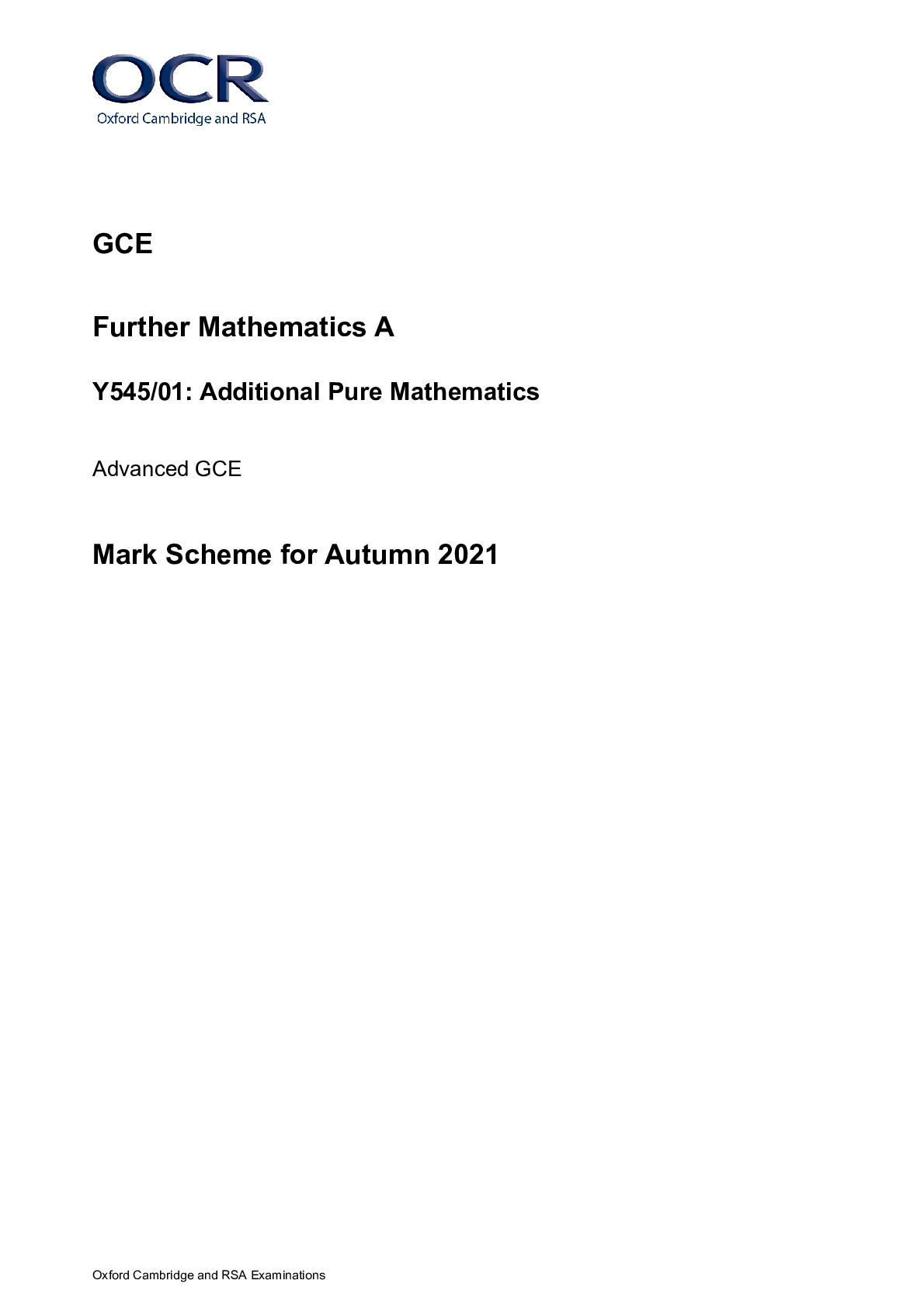
Reviews( 0 )
Document information
Connected school, study & course
About the document
Uploaded On
Oct 11, 2022
Number of pages
13
Written in
Additional information
This document has been written for:
Uploaded
Oct 11, 2022
Downloads
0
Views
62


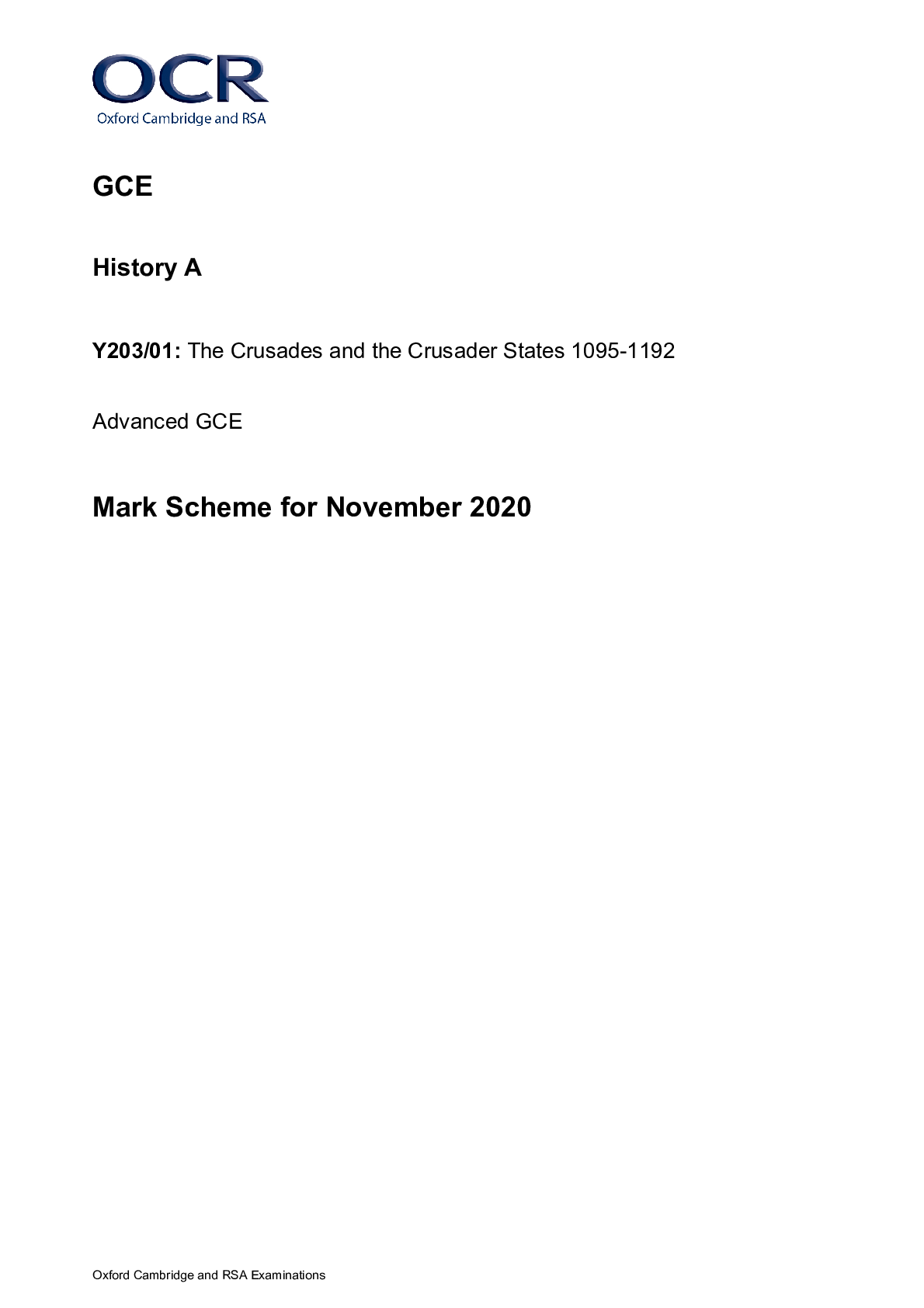
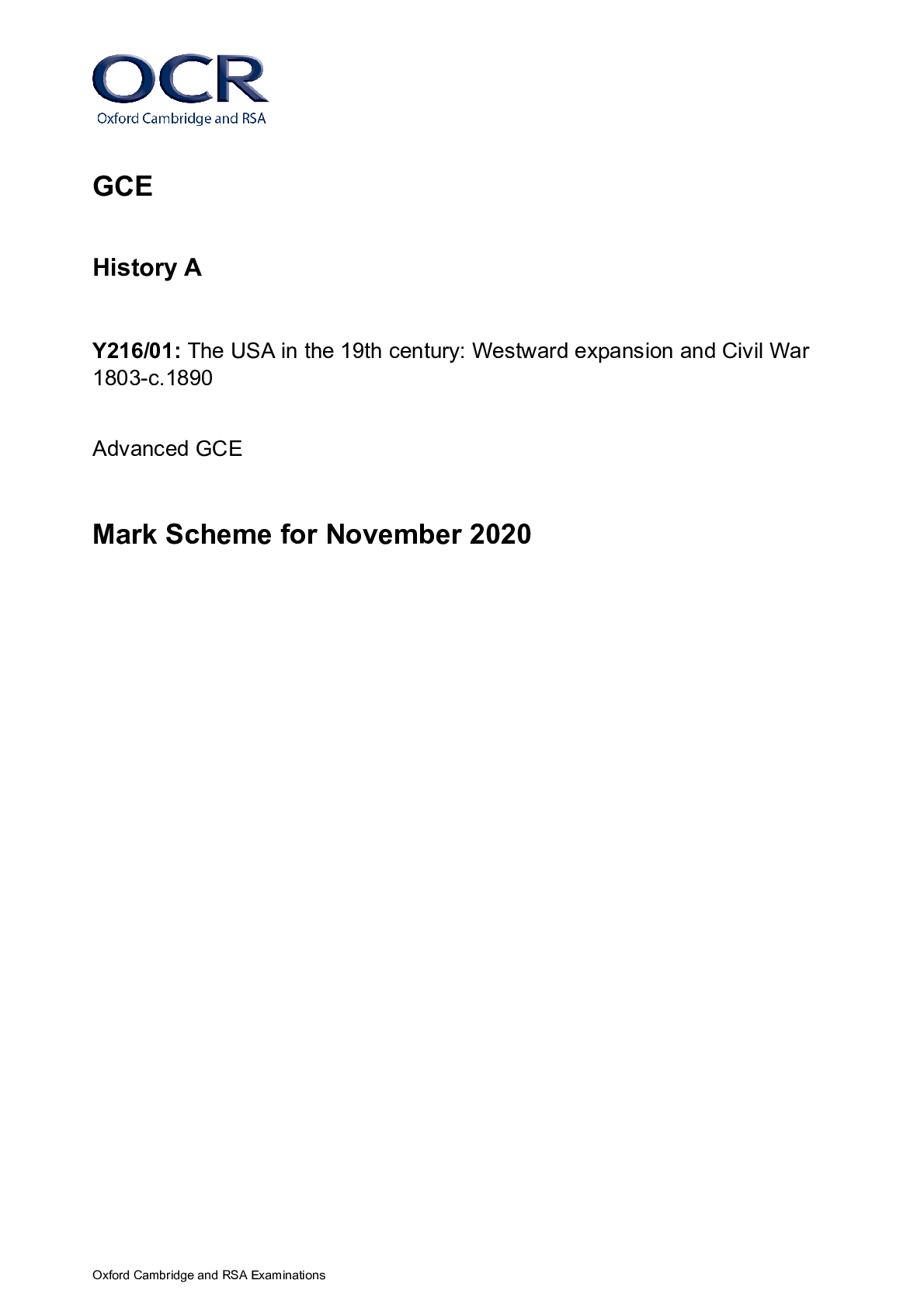
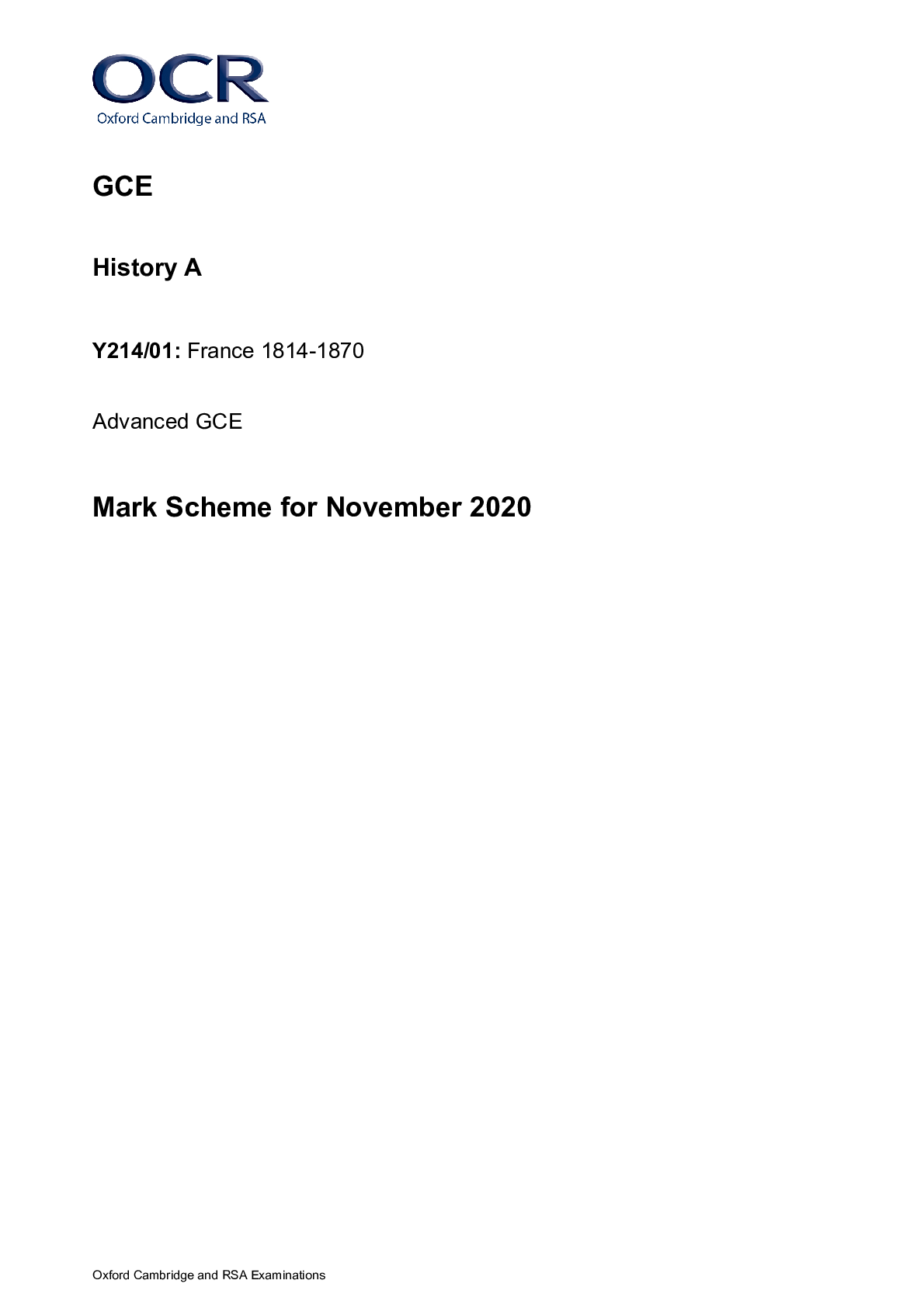



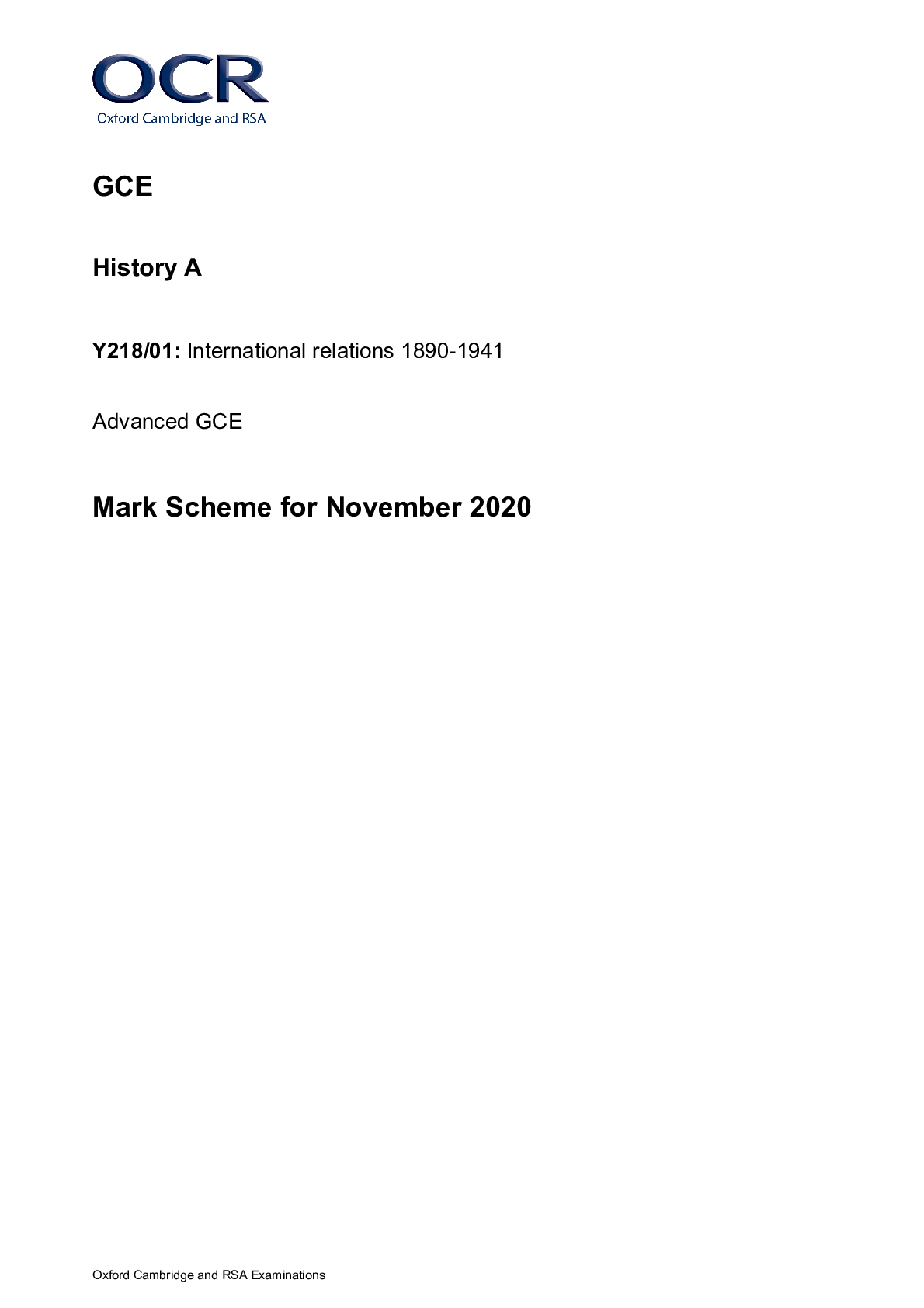
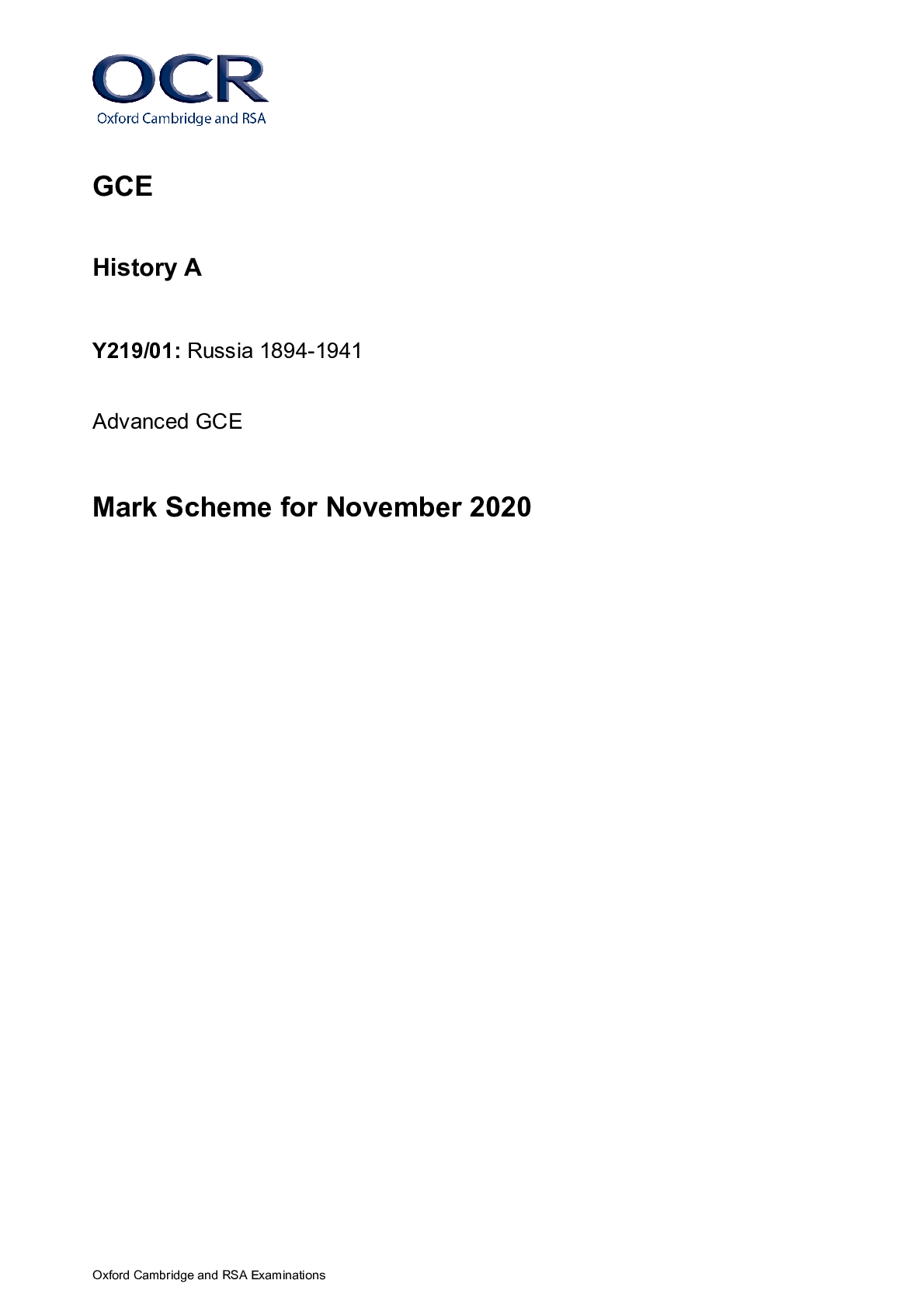







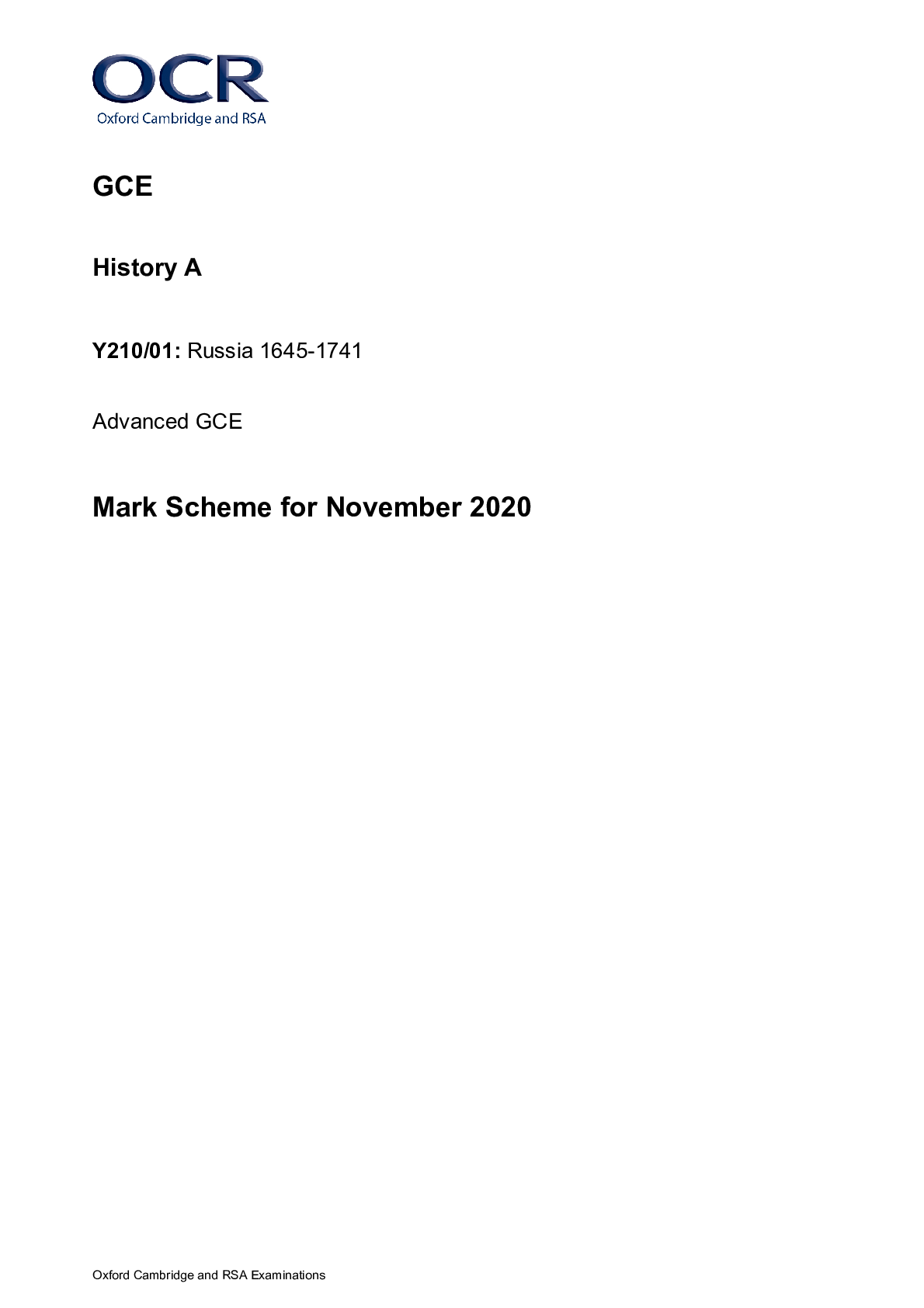


.png)

